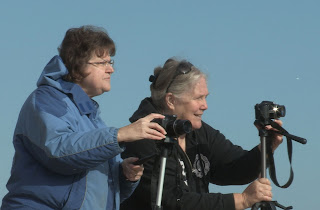 Student Focused, Student Built
Student Focused, Student Built
The success of the NSF Advanced Technological Education
program has been well documented over the years. Thousands of STEM students have benefited
from the curricula, career pathways, internships, summer camp experiences, and
other activities offered by ATE projects and centers, and hundreds of technical
programs continue to feel the positive effects of ATE funding. A smaller number of students work directly
with PIs as part of the project staff; they contribute significantly to project
success, but also have a unique opportunity to build a body of work that sets
them apart from other job seekers after graduation.
 |
| Teri and Kem from Highland Community College |
Two of these students, Teresa Vowell and Kemalie Winter,
from Highland Community College in Freeport, Illinois, showcased their work in
web design, graphic design and animation, scriptwriting, and display design at
this year’s ATE Principal Investigator’s Conference. According to Project Director Phil Pilcher,
Teri and Kem have been an integral part of the project team: “We knew from
previous ATE projects that it’s good to have resources that are available
year-round. While we rely on faculty as
subject matter experts, their activities are concentrated in a two-month period
during the summer break, and the full-time college staff is often too overloaded
to respond when needed. Kem and Teri
devote some hours to the project every week, which allows for a continuity of
effort that produces significant results.”
These results may be seen at www.WindTechTV.org , the project website
designed and maintained by the students. Working
under the direction of project PI Jeff Davidson and Co-PI Pilcher, the students
developed proposals for the web design, launched a prototype site in March,
2011, and completed the site architecture during the summer of 2011. HCC
computer science instructor Jeremy Monigold guided Kem and Teri through the
build process. “They were very eager to
complete a large scale project for a real world client, but those opportunities
are scarce for students,” said Monigold, who serves as technical advisor to the
site. “WindTechTV let them stretch their
skills and add new ones, while learning how to turn the wishes of the project
leaders into a reliable working site.” Because the site relies heavily on video
and animation, Teri and Kem also confronted the challenges of delivering media
from a content delivery network server.
The students faced a completely different challenge when it came
to designing a display for the 2011 PI conference. Pilcher specified that all display materials
must fit in a standard suitcase and meet the airline weight limit of 50
pounds. “We looked at commercial
displays, but thought that we could get something cheaper, lighter, and smaller
if we did it ourselves,” he said. “I had
seen what Teri and Kem did with WindTechTV.org, and was confident that they
could deliver. What they produced is
beautiful, functional, and lightweight. People are astonished when I tell them how little it cost, and that it
was built by our students.”
When asked to describe the experience of working on a funded
research project, Teri had these thoughts:
“It was an incredible learning experience! We used skills acquired in our Dreamweaver,
Flash, Web Programming, and Graphic Design classes that were taken as part of the
Web Design degree. I was able to hone my
skills to the degree that I am currently teaching Dreamweaver at HCC, and will
be teaching Flash Animation next semester. I also feel more confident now about launching my own web design
business.” Kem added: “The projects that
we worked on in class covered basic concepts, but they seemed abstract until we
actually built a working site for a client. The WindTechTV project helped me
bridge the gap between concept and real-world expectations. When I started the project, my goal was to
build a functional, attractive web site, but I have expanded my goals to
include writing, animation, and video production.”
These students are
emblematic of the ATE vision that recognizes students as life-long learners as
well as the needs of the modern workplace. Both looked to their local community college for training in a new
career after pursuing successful careers in other fields. “We were very
fortunate to have students of this caliber enrolled at HCC when we looked for a
design team,” said Pilcher, “but without ATE support, their skills could not
have been put to use, and they would have had a very different community
college experience. I’m sure many
students in ATE-supported programs would say the same thing.”
No comments:
Post a Comment